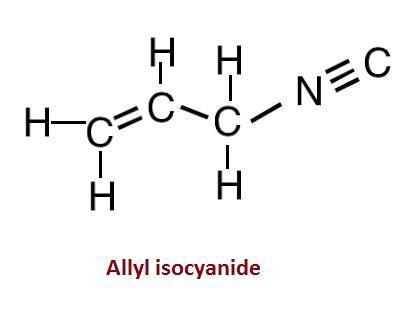
Allyl isocyanide has:
(A) 9σ and 4π – bonds
(B) 8σ and 5π – bonds
(C) 9σ, 3π and 2 non – bonded electron
(D) 8σ, 3π and 4 non – bonded electron
Answer
440.4k+ views
Hint: The molecular formula of Allyl isocyanide is
Step by step answer:

Allyl isocyanide can also be written as
We can see that in the given compound there are seven single bonds, one double bond and one triple bond.
>
> The double bond has 1
> The triple bond has 1
And there are 2 non bonded electrons.
So in the given compound the number of
Therefore, Option C is the correct answer.
Additional Information:
Note: The formula to calculate
Where,
The formula to calculate
Where,
Step by step answer:

Allyl isocyanide can also be written as
We can see that in the given compound there are seven single bonds, one double bond and one triple bond.
>
> The double bond has 1
> The triple bond has 1
And there are 2 non bonded electrons.
So in the given compound the number of
Therefore, Option C is the correct answer.
Additional Information:
Note: The formula to calculate
Where,
The formula to calculate
Where,
Recently Updated Pages
Master Class 11 Economics: Engaging Questions & Answers for Success

Master Class 11 Business Studies: Engaging Questions & Answers for Success

Master Class 11 Accountancy: Engaging Questions & Answers for Success

Master Class 11 English: Engaging Questions & Answers for Success

Master Class 11 Computer Science: Engaging Questions & Answers for Success

Master Class 11 Maths: Engaging Questions & Answers for Success

Trending doubts
Which one is a true fish A Jellyfish B Starfish C Dogfish class 11 biology CBSE

State and prove Bernoullis theorem class 11 physics CBSE

1 ton equals to A 100 kg B 1000 kg C 10 kg D 10000 class 11 physics CBSE

In which part of the body the blood is purified oxygenation class 11 biology CBSE

One Metric ton is equal to kg A 10000 B 1000 C 100 class 11 physics CBSE

Difference Between Prokaryotic Cells and Eukaryotic Cells




